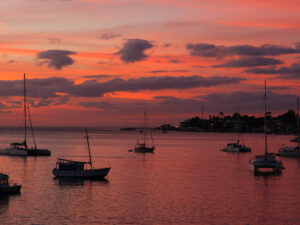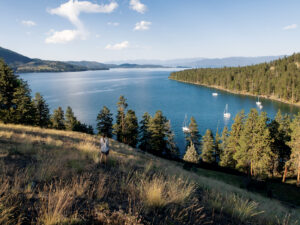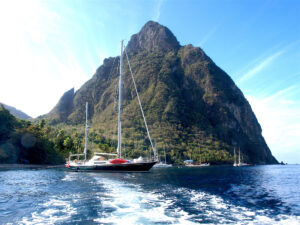As we flew out of American airspace, over the Gulf of Mexico, I had a jumble of feelings I don’t fully get yet. Despite that we were heading home to Ithaka in Guatemala, a recently bloody war-ground, I felt an ironic sense of relief to be heading toward what now may be a safer part of the world. While there’s precious little I could be doing in America to alter the realities there, I felt some guilty twinges at being overwhelmingly glad to be heading back to a life at least physically separated from it.
|
Regardless of our nationalities, cruisers live in a nether world, crossing most borders with minimal fuss, stopping where whim and weather propel us, not encumbered by many day-to-day responsibilities of the lives wed known before. Were outside the onslaught of 24-hour-a-day media reporting, which can keep tensions at a boil and magnify a sense of helplessness. Cruising is an indulgent privilege for which Bernadette and I feel grateful, if sometimes confused. Like most of the important stuff in life, its just too big to fully wrap your head around.
At the Guatemala City airport we gathered our seven bags and cartons, none of which had been opened or inspected since we packed them at home in Newport. (We were carrying an entire radar unit as well as a depth sounder, which in X-ray outline would have leaped out as a six-inch cylinder attached to 30 feet of coiled wire and a small electronics box.) Our carry-on daypacks went through the metal detectors and were hand-searched. But Bernadette and I discovered the next day that wed both forgotten to remove our four-inch pocket knives, which had been totally missed.
|
In Guatemala City, we found that things had changed since September 11th. The traffic lane closest to the American Embassy, a fortress-like structure located in the elegant section of town, Zona 10, was closed off to create a broader buffer, and there were three times the usual number of armed guards around it. There were also offerings of flowers and wreaths that had been left at the fences, including one from the Guatemalan bomberos to honor their fellow firemen in the United States. The front-page news on every Guatemalan newspaper declared, in Spanish, updates to the escalating war. Everyone we met shook their heads and offered condolences.
At the same time, some things were just as when we left. In every major and small street of the capital there was evidence of Guatemala’s great sadness, los niños de la calle—_orphaned street children who sell chiclets or plastic bags of water, or do cartwheels in front of traffic, turning _piruetas po dinero, hoping someone will toss them a few centavos. On other corners there were scrawny children who at six already have developed the 1,000-yard stare—perhaps from sniffing glue, perhaps from hopelessness. It’s hard to tell the difference. There are little girls literally and figuratively saddled with the responsibility of carrying and caring for their siblings. Many look worn out at the age of nine, because they are.
In Guatemala, a country still feeling crushed in the emotional and economic aftermath of 36 years of civil war and terrorist activities, the fledgling peace is calibrated in months and years, not decades. The Coca-cola delivery trucks have guards with sawed off shotguns. Lynching parties are not unheard of and secuestradores (kidnappers) still ply their trade and collect their ransoms. Insidious long-term effects of war are clear.
| | Life in Central America. An advisory posted at the Guatemalan Tourist Board warned that “70 felons broke out of a maximum security prison 40 miles south of Guatemala City. The Guatemalans suspended for 30 days several constitutional guarantees, including protection from arrest without a warrant, and the right to enter and exit the country freely. Expect traffic stops, searches, detention, and interrogation without normal constitutional protections ”* * *|
On the other hand, we walked to the Universidad Francisco Marroquin where two museums celebrate the grandeur of this culture and the indigenous peoples. For hours at the Museo Popul Vuh, we lost ourselves and our thoughts in the pre-Hispanic and Colonial art and archeology. At the Museo Ixchel del Traje Indigena, devoted to modern art and traditional weaving, there was a program that afternoon in which Indian women from a number of village tribes were demonstrating how they wind their long black hair in various braids, knots and designs, interwoven with exquisite 10-foot-long, hand-woven sashes called las fajas or_ las tocayales._ Each hair arrangement and sash is specific to its tribe, and is a badge of pride. Being the only hombre in the crowd, I didn’t get coiffed, but Bernadette with her long hair was enlisted by the women. Crowned in yellows and blue and great red pom-poms, she looked beautiful, if not precisely indigenous.
|
It wasn’t until a day later, after the five-hour bus ride to the Rio Dulce, and after we were on the dock at Tortugal Marina, that I became aware of how much our visit to the States had been a dividing line for me, a natural fissure in time. As we crossed the passarelle from the dock to Ithaka, I knew we were embarking on Chapter Two, that a new phase of cruising is opening up for us. Some of this may be shadowed by events of September 11th, but I sense a greater portion is formed in our transition from cruising freshmen to sophomores. If Year One, half of which was spent in the U.S., was in many ways about starting to find our way, Year Two is about deeper involvement in different cultures and pushing ourselves.
We cant leave the Rio for a little while still. Hurricane season doesnt end just yet, and not too many days back the 140-mph Iris took 19 lives, and left 13,000 homeless just 50 miles north of us, near Placentia, Belize, our old stomping ground.
| | It was a wonderful relief to get back “home” to our familiar surroundings on Ithaka.* * *|
Bernadette and I relished being back on board Ithaka, nosing about the boat, unpacking our gear, re-feathering our nest, seeing how she held up in our absence. First we checked the bilge, which was mercifully dry—a cruiser’s ongoing big fear—and then I double checked the counter on the automatic bilge pump, which read our favorite number: zero. Such is the nature of leaving a boat unattended; our worries mount in direct proportion to distance and time away. We worked our way through the boat, looking for new problems and finding nothing major. Sure there were a couple of new leaks, which I think (hope) I solved over the next few days, and there was some green on the bimini, but that’s about it as far as mildew is concerned, and that ain’t much—this is a jungle, after all. But we found neither rodent droppings nor cucaracha carcasses, and that was a major relief. There was an expectable amount of corrosion, and two of the wires on the port side solar panel had melted away, but once scraped and re-taped, juice was pumping again. We had disconnected them in our absence to make sure we didn’t boil the batteries. In the first few days we changed the oil and filters, lubed the outboard, cleaned the plugs, washed off some salt, inflated the dinghy and regained some routine.
| | Every day that it didnt rain, Arnulfo opened the companionway to air the boat and prevent mildew.* * *|
Returning to Ithaka, after time in houses and hotels, she somehow seemed smaller, and it took us a while to re-adjust our sense of proportion, but maybe that’s universal in all transitions. To both Bernadette and me, she looked wonderful. During our absence, Arnulfo, at Tortugal Marina, opened the companionway every day it didn’t rain to keep the boat aired out. He started the engine once a week; he cleaned and waxed the stainless steel and hull, sanded down the toe rail, and added a half dozen coats of varnish to the butterfly and forward hatches. Rates here are 100 quetzals ($12.90) a day. That’s about $1.60 an hour, and the work is first-rate.
In addition to the boat being taken care of physically, wed arranged for M. E. (pronounced Emy) Langdon, an American woman who sailed into the Rio many years ago and never left, to take care of our visa extension. Her business card reads “Property Management Services, Assisting Absentee Property and Boat owners since 1993.” Initial entry in Guatemala is granted for one month, but can be extended for up to a year, and Emy is the local visa maven, carting boat papers and forms to the customs office, down-river in Livingston, performing her magic, and returning with stickers and stamps. If you ever want to reach her, she stands by locally on VHF 11, or can be faxed at (502) 203 8860.
| | Calm on the Rio* * *|
One dusk at Tortugal a few nights ago, we sat with a group of cruisers on the wood deck overlooking the river, and sipped cold beers. With us were other sailors from France, Belgium, Germany, Switzerland, Argentina, and the United States; all of them had kept their boats here for hurricane season. Over the summer, some had returned home to work or visit. Some had traveled around Central America. A few had remained at Tortugal and accomplished major refit projects on their boats. Everyone was psyched to push off again, some for Honduras, some for Cuba, some for the States and then Europe, others hell-bent for the canal.
|
We spoke of where we were going and war; of whom and what we’d left behind. Several had lived with terrorism and all, save us, had known full-fledged wars on their homelands. We spoke of perils seen and unseen, of smallpox and anthrax. Summing up the ironies of our lives, referring both to freedom and danger, one man said: “En las buenas y en las malas, cuando el viento sopla, no hay fronteras” — roughly translated, “in good times, in bad times, when the wind blows, there are no borders.”








